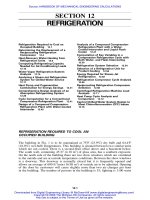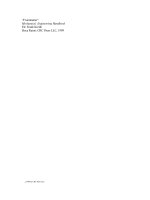Engineering Tribology P1
Bạn đang xem bản rút gọn của tài liệu. Xem và tải ngay bản đầy đủ của tài liệu tại đây (895.22 KB, 40 trang )
TeamLRN
E NGINEERING TRIBOLOGY
TEAM LRN
TEAM LRN
ENGINEERING TRIBOLOGY
Gwidon W. Stachowiak
Department of Mechanical and Materials Engineering,
University of Western Australia, Australia
Andrew W. Batchelor
Department of Mechanical and Materials Engineering,
University of Western Australia, Australia
TEAM LRN
TEAM LRN
To the most important persons in our lives
Grazyna Stachowiak
Gwidon (Jr.) Stachowiak
and
Valli M. Batchelor
Vicky & Diana Batchelor
TEAM LRN
TEAM LRN
CONTENTS
1 INTRODUCTION 1
1.1 Background 1
1.2 Meaning of tribology 2
Lubrication 3
Wear 5
1.3 Cost of friction and wear 5
1.4 Summary 7
References 8
2 PHYSICAL PROPERTIES OF LUBRICANTS 11
2.1 Introduction 11
2.2 Oil viscosity 11
Dynamic viscosity 12
Kinematic viscosity 13
2.3 Viscosity temperature relationship 13
Viscosity-temperature equations 14
Viscosity-temperature chart 14
2.4 Viscosity index 15
2.5 Viscosity pressure relationship 16
2.6 Viscosity-shear rate relationship 22
Pseudoplastic behaviour 22
Thixotropic behaviour 24
2.7 Viscosity measurements 24
Capillary viscometers 24
Rotational viscometers 26
· Rotating cylinder viscometer 27
· Cone on plate viscometer 28
Other viscometers 29
2.8 Viscosity of mixtures 30
2.9 Oil viscosity classification 31
TEAM LRN
VIII E
NGINEERING
T
RIBOLOGY
SAE viscosity classification 31
ISO viscosity classification 33
2.10 Lubricant density and specific gravity 33
2.11 Thermal properties of lubricants 34
Specific heat 34
Thermal conductivity 35
Thermal diffusivity 35
2.12 Temperature characteristics of lubricants 35
Pour point and cloud point 36
Flash point and fire point 37
Volatility and evaporation 37
Oxidation stability 38
Thermal stability 39
Surface tension 40
Neutralization number 42
Carbon residue 43
2.13 Optical properties of lubricants 43
Refractive index 43
2.14 Additive compatibility and solubility 44
Additive compatibility 44
Additive solubility 44
2.15 Lubricant impurities and contaminants 44
Water content 44
Sulphur content 45
Ash content 45
Chlorine content 45
2.16 Solubility of gases in oils 45
2.17 Summary 48
References 48
3 LUBRICANTS AND THEIR COMPOSITION 51
3.1 Introduction 51
3.2 Mineral oils 52
Sources of mineral oils 52
Manufacture of mineral oils 54
Types of mineral oils 56
· Chemical forms 56
· Sulphur content 57
· Viscosity 57
TEAM LRN
C
ONTENTS
IX
3.3 Synthetic oils 57
Manufacturing of synthetic oils 58
Hydrocarbon synthetic lubricants 60
· Polyalphaolefins 60
· Polyphenyl ethers 60
· Esters 60
· Cycloaliphatics 61
· Polyglycols 61
Silicon analogues of hydrocarbons 62
· Silicones 62
· Silahydrocarbons 62
Organohalogens 62
· Perfluoropolyethers 63
· Chlorofluorocarbons 63
· Chlorotrifluoroethylenes 63
· Perfluoropolyalkylethers 63
3.4 Emulsions and aqueous lubricants 65
Manufacturing of emulsions 65
Characteristics 65
Applications 66
3.5 Greases 66
Manufacturing of greases 66
Composition 67
· Base oils 67
· Thickener 67
· Additives 68
· Fillers 69
Lubrication mechanism of greases 69
Grease characteristics 72
· Consistency of greases 72
· Mechanical stability 73
· Drop point 74
· Oxidation stability 75
· Thermal stability 75
· Evaporation loss 76
· Grease viscosity characteristics 76
Classification of greases 78
Grease compatibility 80
Degradation of greases 80
TEAM LRN
X E
NGINEERING
T
RIBOLOGY
3.6 Lubricant additives 81
Wear and friction improvers 82
· Adsorption or boundary additives 82
· Anti-wear additives 83
· Extreme pressure additives 85
Anti-oxidants 86
· Oil oxidation 86
· Oxidation inhibitors 88
Corrosion control additives 91
Contamination control additives 92
Viscosity improvers 93
Pour point depressants 95
Foam inhibitors 95
Interference between additives 95
3.7 Summary 96
References 97
4 HYDRODYNAMIC LUBRICATION 101
4.1 Introduction 101
4.2 Reynolds equation 101
Simplifying assumptions 103
Equilibrium of an element 103
Continuity of flow in a column 107
Simplifications to the Reynolds equation 109
· Unidirectional velocity approximation 109
· Steady film thickness approximation 109
· Isoviscous approximation 110
· Infinitely long bearing approximation 110
· Narrow bearing approximation 111
Bearing parameters predicted from Reynolds equation 113
· Pressure distribution 113
· Load capacity 113
· Friction force 114
· Coefficient of friction 115
· Lubricant flow 115
Summary 115
4.3 Pad bearings 116
Infinite linear pad bearing 116
· Bearing geometry 116
TEAM LRN
C
ONTENTS
XI
· Pressure distribution 117
· Load capacity 119
· Friction force 120
· Coefficient of friction 123
· Lubricant flow rate 124
Infinite Rayleigh step bearing 125
Other wedge geometries of infinite pad bearings 128
· Tapered land wedge 128
· Parabolic wedge 129
· Parallel surface bearings 130
· Spiral groove bearing 131
Finite pad bearings 132
Pivoted pad bearing 133
Inlet boundary conditions in pad bearing analysis 135
4.4 Converging-diverging wedges 137
Bearing geometry 138
Pressure distribution 138
· Full-Sommerfeld boundary condition 140
· Half-Sommerfeld boundary condition 141
· Reynolds boundary condition 143
Load capacity 144
4.5 Journal bearings 146
Evaluation of the main parameters 146
· Bearing geometry 146
· Pressure distribution 148
· Load capacity 149
· Friction force 154
· Coefficient of friction 155
· Lubricant flow rate 156
Practical and operational aspects of journal bearings 158
· Lubricant supply 159
· Cavitation 163
· Journal bearings with movable pads 164
· Journal bearings incorporating a Rayleigh step 164
· Oil whirl or lubricant caused vibration 165
· Rotating load 167
· Tilted shafts 169
· Partial bearings 170
· Elastic deformation of the bearing 171
TEAM LRN
XII E
NGINEERING
T
RIBOLOGY
· Infinitely long approximation in journal bearings 172
4.6 Thermal effects in bearings 172
Heat transfer mechanisms in bearings 173
· Conduction 174
· Convection 174
· Conducted/convected heat ratio 175
Isoviscous thermal analysis of bearings 176
· Iterative method 176
· Constant flow method 178
Non-isoviscous thermal analysis of bearings with locally varying viscosity 178
Multiple regression in bearing analysis 179
Bearing inlet temperature and thermal interaction between pads of a
Michell bearing 181
4.7 Limits of hydrodynamic lubrication 182
4.8 Hydrodynamic lubrication with non-Newtonian fluids 184
Turbulence and hydrodynamic lubrication 184
Hydrodynamic lubrication with non-Newtonian lubricants 185
Inertial effects in hydrodynamics 186
Compressible fluids 187
Compressible hydrodynamic lubrication in gas bearings 189
4.9 Reynolds equation for squeeze films 191
Pressure distribution 192
Load capacity 193
Squeeze time 194
Cavitation and squeeze films 195
Microscopic squeeze film effects between rough sliding surfaces 196
4.10 Porous bearings 196
4.11 Summary 197
References 198
5 COMPUTATIONAL HYDRODYNAMICS 201
5.1 Introduction 201
5.2 Non-dimensionalization of the Reynolds equation 201
5.3 The Vogelpohl parameter 202
5.4 Finite difference equivalent of the Reynolds equation 204
Definition of solution domain and boundary conditions 206
Calculation of pressure field 207
Calculation of dimensionless friction force and friction coefficient 207
Numerical solution technique for Vogelpohl equation 210
TEAM LRN
C
ONTENTS
XIII
5.5 Numerical analysis of hydrodynamic lubrication in idealized journal
and partial arc bearings 210
Example of data from numerical analysis, the effect of shaft misalignment 211
5.6 Numerical analysis of hydrodynamic lubrication in a real bearing 216
5.6.1 Thermohydrodynamic lubrication 216
Governing equations and boundary conditions in
thermohydrodynamic lubrication 217
· Governing equations in thermohydrodynamic lubrication for a
one-dimensional bearing 218
· Thermohydrodynamic equations for the finite pad bearing 221
· Boundary conditions 222
Finite difference equations for thermohydrodynamic lubrication 223
Treatment of boundary conditions in thermohydrodynamic lubrication 226
Computer program for the analysis of an infinitely long pad bearing in
the case of thermohydrodynamic lubrication 227
Example of the analysis of an infinitely long pad bearing in the case of
thermohydrodynamic lubrication 228
5.6.2 Elastic deformations in a pad bearing 231
Computer program for the analysis of an elastically deforming one-
dimensional pivoted Michell pad bearing 233
Effect of elastic deformation of the pad on load capacity and film thickness 233
5.6.3 Cavitation and film reformation in grooved journal bearings 236
Computer program for the analysis of grooved 360° journal bearings 240
Example of the analysis of a grooved 360° journal bearing 240
5.6.4 Vibrational stability in journal bearings 246
Determination of stiffness and damping coefficients 246
Computer program for the analysis of vibrational stability in a partial arc
journal bearing 251
Example of the analysis of vibrational stability in a partial arc journal bearing 251
5.7 Summary 254
References 254
6 HYDROSTATIC LUBRICATION 257
6.1 Introduction 257
6.2 Hydrostatic bearing analysis 258
Flat circular hydrostatic pad bearing 258
· Pressure distribution 258
· Lubricant flow 259
· Load capacity 259
· Friction torque 260
TEAM LRN
XIV E
NGINEERING
T
RIBOLOGY
· Friction power loss 262
Non-flat circular hydrostatic pad bearings 262
· Pressure distribution 263
· Lubricant flow 264
· Load capacity 265
· Friction torque 265
· Friction power loss 265
6.3 Generalized approach to hydrostatic bearing analysis 266
Flat circular pad bearings 266
Flat square pad bearings 266
6.4 Optimization of hydrostatic bearing design 267
Minimization of power 267
· Low speed recessed bearings 269
· High speed recessed bearings 269
Control of lubricant film thickness and bearing stiffness 270
· Stiffness with constant flow method 271
· Stiffness with capillary restrictors 271
· Stiffness with an orifice 273
· Stiffness with pressure sensors 274
6.5 Aerostatic bearings 275
Pressure distribution 276
Gas flow 276
Load capacity 277
Friction torque 277
Power loss 278
6.6 Hybrid bearings 278
6.7 Stability of hydrostatic and aerostatic bearings 278
6.8 Summary 279
References 279
7 ELASTOHYDRODYNAMIC LUBRICATION 281
7.1 Introduction 281
7. 2 Contact stresses 282
Simplifying assumptions to Hertz's theory 282
Stress status in static contact 283
Stress status in lubricated rolling and sliding contacts 283
7.3 Contact between two elastic spherical or spheroidal bodies 284
Geometry of contacting elastic bodies 285
· Two elastic bodies with convex surfaces in contact 286
TEAM LRN
C
ONTENTS
XV
· Two elastic bodies with one convex and one flat surface in contact 287
· Two elastic bodies with one convex and one concave surface in
contact 288
Contact area, pressure, maximum deflection and position of the
maximum shear stress 289
· Contact between two spheres 289
· Contact between a sphere and a plane surface 292
· Contact between two parallel cylinders 294
· Contact between two crossed cylinders with equal diameters 297
· Elliptical contact between two elastic bodies, general case 299
Total deflection 304
7.4 Elastohydrodynamic lubricating films 305
Effects contributing to the generation of elastohydrodynamic films 306
· Hydrodynamic film formation 306
· Modification of film geometry by elastic deformation 306
· Transformation of lubricant viscosity and rheology under pressure 307
Approximate solution of Reynolds equation with simultaneous elastic
deformation and viscosity rise 307
Pressure distribution in elastohydrodynamic films 311
Elastohydrodynamic film thickness formulae 312
Effects of the non-dimensional parameters on EHL contact pressures and
film profiles 313
· Effect of the speed parameter 313
· Effect of the materials parameter 314
· Effect of load parameter 314
· Effect of ellipticity parameter 315
Lubrication regimes in EHL - film thickness formulae 316
· Isoviscous-rigid 317
· Piezoviscous-rigid 318
· Isoviscous-elastic 318
· Piezoviscous-elastic 318
Identification of the lubrication regime 319
Elastohydrodynamic film thickness measurements 319
7.5 Micro-elastohydrodynamic lubrication and mixed or partial EHL 322
Partial or mixed EHL 323
Micro-elastohydrodynamic lubrication 325
7.6 Surface temperature at the conjunction between contacting solids and
its effect on EHL 327
Calculation of surface conjunction temperature 328
· Flash temperature in circular contacts 331
TEAM LRN









